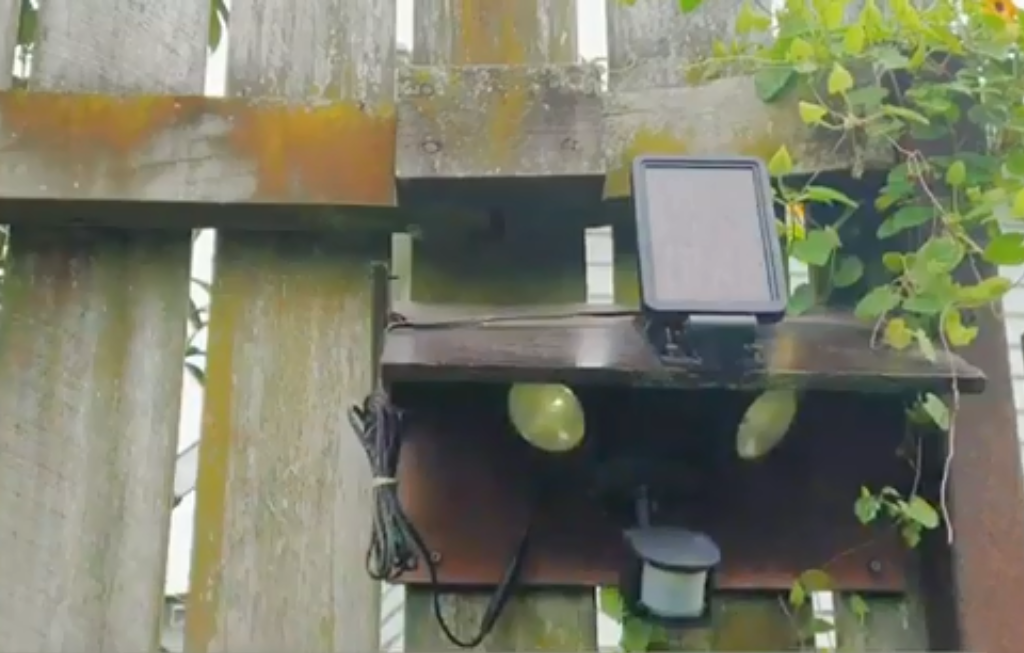I find myself watering the plants in the garden very late in the day when I come home from work. Around that time, I lose light very quick as I fumble through the perimeter of my garden trying to aim the slender spout of my watering can inside the pots as best as I can.
I do have an outdoor light by the kitchen door, but it isn’t enough to reach the corners of the garden where most of my plants are. And so here I am researching the best way and simple way to setup of some solar lights that can be triggered with motion.

Setup sensor lights in commonly busy areas in the garden.
The best place to place outdoor solar lights is in areas where you do most of your nightly garden activities, or those that you always need access to.
It would vary on your personal needs, as some people entertain in their garden, while others like me, only need solar lights to get my gardening tasks done.
Here are some of the places where you might consider installing your lights so that your garden is still functional and pretty even after dark.
Doorway or Entry/Exit points. This is also for security reason, as having solar lights would alert you on any intruder in your property. Or it could help those unexpected guests to see their way and find the doorbell.I would actually want to put one by my garden gate (when I eventually get to building the gate).
Pathways. This could be leading you to the garage, the shed, or other entry points in the house. Most of my plants are along the perimeter of my fence, which makes it difficult for me when I need to water the plants at dusk after coming home from work. It would be helpful to light the pathway that you’re always using.
Sitting area. It could be in a pocket space somewhere in the corner of the garden, or it may be the entire deck or patio. I like coming out into the garden every evening after I’ve eaten my supper to have a breath of fresh night air. While I do have a small cafe set out where I can sit down, I usually hang out by the kitchen door because that’s the only source of light that my garden has right now.
Potting bench area. While I don’t have a potting bench yet, I have an area where I keep some buckets containing some of my seeds and garden tools. There are times when I need to grab something there at night but then remember I don’t have a light source in that area.
Outdoor Faucet. Since I water my garden late in the day, I do need lighting over our outdoor faucet. You may also find yourself needing to use the faucet when you have an outdoor gathering in the garden.
Use solar powered lights for easy installation in the garden of a rental home.
We live in a rental home which means that the garden I’m growing my plants on is not really mine. It is difficult to install expensive lighting and trying to run wires along the garden when there’s no assurance of how long we can enjoy them for. We can move houses at any time! And I need something that I can easily install myself.
Some would suggest using those alkaline-battery powered lights but I think they won’t be as bright as I’d want. I don’t even want to think about how to dispose of those batteries. I bet they’re only good for a few days until the need replacing. I just don’t like having to go through several of them every now and then.
Solar lighting is also more commonly sold in our garden centers and they come at reasonable prices too. So while others may argue that you may also need to be replaced eventually, it would be more practical in my situation as a renter.
Solar lights also uses internal rechargeable batteries that emit a brighter light than traditional alkaline batteries. They normally use Ni-cd (nickel cadmium), Ni-MD (nickel metal hydride) or lithium. They’re all reusable, contain less toxic chemicals, and have a longer life span, with lithium lasting the longest, typically 4-5 years, before replacement batteries are required.
And when using LED instead of traditional incandescent or fluorescent bulbs, you only need little energy to emit powerful light. This means that solar lights is a better option.
I did notice that a lot of gardeners have complained in Facebook groups about the weak output of solar lights. I think this is because there are a lot of cheaply manufactured solar lights being sold that are designed to be smaller and somewhat of a “disposable” type. Smaller solar panels and smaller batteries means weak lighting and a shorter life expectancy.

Get Solar Lights with a Separate solar panel
When it comes to solar lighting, size does matter. I’ve researched that the best solar lights are those that come with a separate solar panel because it’s larger and sturdier than those that feature both like this one.
With a separate solar panel, this means that it’s not restricted to the small area wherein the light head is fixed. A bigger solar panel means more solar cells, more solar cells means faster battery charging. A typical charge is around 8-10 hours, but with a large solar panel, a charge may only need 4-6 hours of sun exposure.
Also, with a separate solar panel, you can mount it in area where it can get full access to sunlight throughout the day. This ensures adequate power is emitted all night, and that it can achieve a full charge all throughout the day.
Get solar lights with motion sensors
Solar light batteries are designed to charge as long as it could so that it could provide light as long it has the capacity to. But even after a day’s worth of charge would only give you a couple of hours worth of light. This means that we don’t want our solar lights to be switched on when we don’t need them to.
Enter solar lights with motion sensors. Motion sensors enable you to save power when you don’t need it. This means that it only switches on when it detects you moving around.
Sensor lights with motion sensor, or motion lights, usually have both the motion sensor adjustment (sens) and the light level adjustment (lux).
The motion sensor on some may be temperature-sensitive. It becomes more sensitive when the temperature is cooler. This is when you may need to adjust it by slowly walking around the area of detection. Make adjustments as needed until the desired level of sensitivity is reached. If the light doesn’t switch on at all, you may need to adjust the angle of the sensor.
The light sensor prevents the light from operating during the day when it’s bright outside, and only activates when light is low. You can activate it to switch on at dusk or after dark. You can also switch it on and off if you want more control of when to use the power charge.
When the charging ability of the batteries decreases, it might be time to replace the batteries.
Consider Installing small stick-on battery-powered LED nightlights
For those areas that don’t really need bright lighting, but still needs some kind of luminance, there are small battery-operated stick-on nightlights that you can buy at cheap prices. There are also solar ones like these that are water-proof and have a light sensor.
The thing I like about them is that they’re small, light, and super easy to install. No wiring or anything, just stick it on and it’s good to go. Very convenient!
They’re not very good for general or task lighting, but they provide enough light for those times like when you just don’t want to trip over anything.
These things also have a motion sensor so it’s very convenient. They switch on and off when it detects you moving, and you can quickly do your thing. They’re useful for stair steps or other trip hazards.




